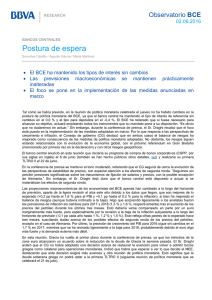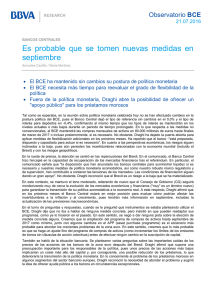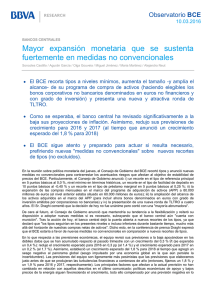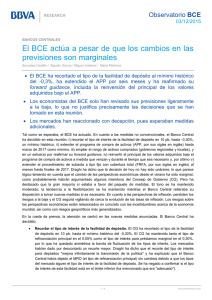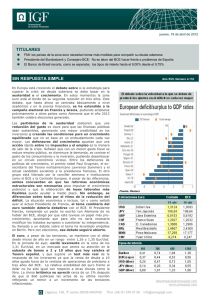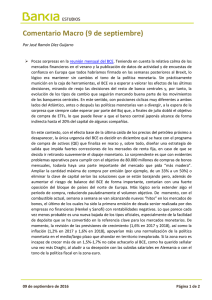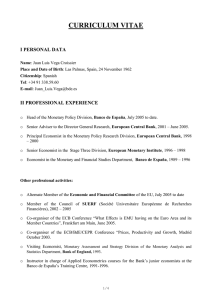El BCE emplea un tono moderado
Anuncio
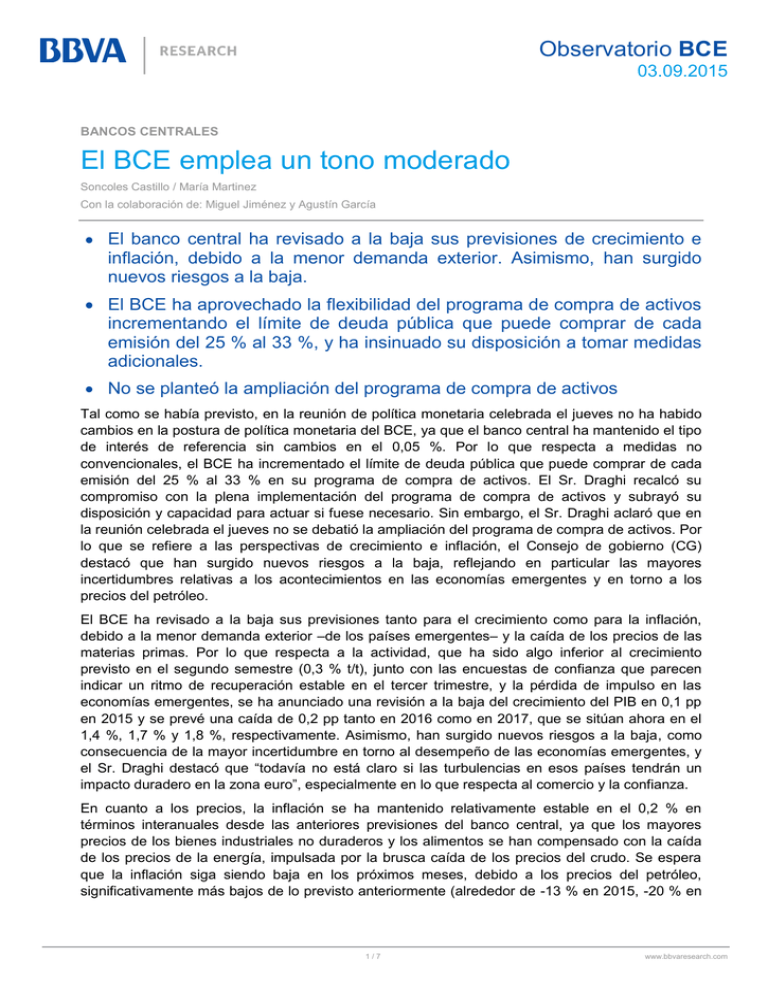
Observatorio BCE 03.09.2015 BANCOS CENTRALES El BCE emplea un tono moderado Soncoles Castillo / María Martinez Con la colaboración de: Miguel Jiménez y Agustín García El banco central ha revisado a la baja sus previsiones de crecimiento e inflación, debido a la menor demanda exterior. Asimismo, han surgido nuevos riesgos a la baja. El BCE ha aprovechado la flexibilidad del programa de compra de activos incrementando el límite de deuda pública que puede comprar de cada emisión del 25 % al 33 %, y ha insinuado su disposición a tomar medidas adicionales. No se planteó la ampliación del programa de compra de activos Tal como se había previsto, en la reunión de política monetaria celebrada el jueves no ha habido cambios en la postura de política monetaria del BCE, ya que el banco central ha mantenido el tipo de interés de referencia sin cambios en el 0,05 %. Por lo que respecta a medidas no convencionales, el BCE ha incrementado el límite de deuda pública que puede comprar de cada emisión del 25 % al 33 % en su programa de compra de activos. El Sr. Draghi recalcó su compromiso con la plena implementación del programa de compra de activos y subrayó su disposición y capacidad para actuar si fuese necesario. Sin embargo, el Sr. Draghi aclaró que en la reunión celebrada el jueves no se debatió la ampliación del programa de compra de activos. Por lo que se refiere a las perspectivas de crecimiento e inflación, el Consejo de gobierno (CG) destacó que han surgido nuevos riesgos a la baja, reflejando en particular las mayores incertidumbres relativas a los acontecimientos en las economías emergentes y en torno a los precios del petróleo. El BCE ha revisado a la baja sus previsiones tanto para el crecimiento como para la inflación, debido a la menor demanda exterior –de los países emergentes– y la caída de los precios de las materias primas. Por lo que respecta a la actividad, que ha sido algo inferior al crecimiento previsto en el segundo semestre (0,3 % t/t), junto con las encuestas de confianza que parecen indicar un ritmo de recuperación estable en el tercer trimestre, y la pérdida de impulso en las economías emergentes, se ha anunciado una revisión a la baja del crecimiento del PIB en 0,1 pp en 2015 y se prevé una caída de 0,2 pp tanto en 2016 como en 2017, que se sitúan ahora en el 1,4 %, 1,7 % y 1,8 %, respectivamente. Asimismo, han surgido nuevos riesgos a la baja, como consecuencia de la mayor incertidumbre en torno al desempeño de las economías emergentes, y el Sr. Draghi destacó que “todavía no está claro si las turbulencias en esos países tendrán un impacto duradero en la zona euro”, especialmente en lo que respecta al comercio y la confianza. En cuanto a los precios, la inflación se ha mantenido relativamente estable en el 0,2 % en términos interanuales desde las anteriores previsiones del banco central, ya que los mayores precios de los bienes industriales no duraderos y los alimentos se han compensado con la caída de los precios de la energía, impulsada por la brusca caída de los precios del crudo. Se espera que la inflación siga siendo baja en los próximos meses, debido a los precios del petróleo, significativamente más bajos de lo previsto anteriormente (alrededor de -13 % en 2015, -20 % en 1/7 www.bbvaresearch.com Observatorio BCE 03.09.2015 2016 y -17% en 2017), lo que debería tener un menor efecto base a finales de este año y un incremento más lento en 2016 y 2017. Sin embargo, la inflación estará soportada por la recuperación económica y el efecto de traslado –principalmente a los bienes no industriales– de un euro débil. Como consecuencia, la inflación se ha revisado a la baja en 0,2 pp, 0,4 pp y 0,1 pp en 2015, 2016 y 2017 al 0,1 %, 1,1 % y 1,7 %, respectivamente. El Sr. Draghi restó importancia a la posibilidad de tasas de inflación negativas en los próximos meses, ya que los precios del petróleo únicamente deberían tener un efecto transitorio, mientras que las previsiones de la inflación subyacente permanecen sin cambios. Sin embargo, subrayó que si se tienen en cuenta los acontecimientos más recientes, en relación con los precios del petróleo y los tipos de cambio, existen riesgos a la baja en la próxima actualización de previsiones de inflación. En la conferencia de prensa, el Sr. Draghi dejó la puerta abierta a tomar más medidas si fuese necesario. En particular, resaltó que el programa de compra de activos proporciona suficiente flexibilidad en términos de ajuste del tamaño, de la composición y de la duración del programa. En este contexto, el banco central anunció hoy un ligero cambio en el plan de compra de activos; esta modificación debería permitirle comprar una mayor cantidad de cada emisión individual de bonos, incrementando el límite inicial del 25 % hasta el 33 % (previa verificación caso por caso de que este aumento no cree una situación en la que el Eurosistema pueda constituir una minoría de bloqueo). El Sr. Draghi señaló que esta medida tiene como objetivo permitir una implementación sin sobresaltos del programa actual, hasta alcanzar el objeto mensual de 60.000 millones de euros. En esta reunión, Grecia ha atraído menos atención que en la última, ya que el tercer rescate se había acordado en julio. No obstante, el Sr. Draghi afirmó que es demasiado pronto para tomar una decisión sobre la oportunidad de reconsiderar la decisión de no adquirir deuda pública griega, ya que Grecia debe alcanzar una serie de hitos de desempeño en los próximos meses. Asimismo, el BCE ha reducido la inyección de liquidez de emergencia (ELA) para los bancos griegos (de 89.700 millones de euros a 89.100 millones). En resumen, el mensaje del BCE ha sido más moderado de lo previsto, lo que parece apoyar el actual clima de creciente incertidumbre. El BCE volvió a insistir en su intención de llevar a cabo el programa de compra de activos hasta finales de septiembre de 2016, o incluso más allá si fuese necesario, y subrayó la posibilidad de realizar ajustes en el programa si fuera necesario. Aunque la incertidumbre es elevada y los riesgos permanecen a la baja, siempre y cuando se estabilice el crecimiento en China y en los principales mercados emergentes (nuestro escenario central), así como en los mercados financieros, consideramos que el escenario más probable es que el BCE se mantenga a la espera. 2/7 www.bbvaresearch.com Observatorio BCE 03.09.2015 DESTACADO: sobre el formato del comunicado del BCE: El aparente formato “control de cambios” que se emplea a continuación tiene por objeto facilitar el seguimiento de cambios del comunicado respecto a la anterior reunión del BCE. En negro aparece la parte del comunicado que se mantiene sin cambios. En azul y subrayado las novedades de la última reunión y en rojo y tachado, el texto que no aparece en el nuevo comunicado Mario Draghi, President of the ECB, Vítor Constâncio, Vice-President of the ECB, Frankfurt am Main, 3 September16 July 2015 Ladies and gentlemen, the Vice-President and I are very pleased to welcome you to our press conference. We will now report on the outcome of today’s meeting of the Governing Council. As usual, let me start with the decisions taken, which was also attended by the Commission Vice-President, Mr Dombrovskis. Based on our regular economic and monetary analysisanalyses, and in line with our forward guidance, the Governing Councilwe decided to keep the key ECB interest rates unchanged. Our asset purchase programme continues to proceed smoothly. Regarding non-standard monetary policy measures, following the announced review of the public sector purchase programme’s issue share limit after the first six months of purchases, the Governing Council decided to increase the issue share limit from the initial limit of 25% to 33%, subject to a case-by-case verification that this would not create a situation whereby the Eurosystem would have blocking minority power, in which case the issue share limit would remain at 25%. Underlying our monetary policy assessment was a review of recent data, new staff macroeconomic projections and an interim evaluation of recent market fluctuations. The information available indicates a continued though somewhat weaker economic recovery and a slower increase in inflation rates compared with earlier expectations. More recently, renewed downside risks have emerged to the outlook for growth and inflation. However, owing to sharp fluctuations in financial and commodity markets, the Governing Council judged it premature to concludethe asset purchase programmes continue to proceed smoothly. As explained on whether these developments could have a lasting impact on the outlook for prices and on the achievement of a sustainable path of inflation towards our medium-term aim, or whether they should be considered to be mainly transitory. Accordingly, the Governing Council will closely monitor all relevant incoming information. It emphasises its willingness and ability to act, if warranted, by using all the instruments available within its mandate and, in particular, recalls that the asset purchase programme provides sufficient flexibility in terms of adjusting the size, composition and duration of the programme. 3/7 www.bbvaresearch.com Observatorio BCE 03.09.2015 In the meantime, we will fully implementprevious occasions, our monthly asset purchases of €60 billion. These purchases have a favourable impact on the cost and availability of credit for firms and households. They are intended to run until the end of September 2016, or beyond, if necessary, and, in any case, until we see a sustained adjustment in the path of inflation that is consistent with our aim of achieving inflation rates below, but close to, 2% over the medium term. When carrying out its assessment, the Governing Council will follow its monetary policy strategy and concentrate on trends in inflation and the medium-term outlook for price stability. All in all, the information that has become available since the Governing Council meeting in early June has been broadly in line with our expectations. Recent developments in financial markets, which partly reflect greater uncertainty, have not changed the Governing Council’s assessment of a broadening of the euro area’s economic recovery and a gradual increase in inflation rates over the coming years. The ECB’s monetary policy stance remains accommodative and market-based inflation expectations have, on balance, stabilised or recovered further since our meeting in early June. The latest information also remains consistent with a continued pass-through of our monetary policy measures to the cost and availability of credit for firms and households. Our measures thereby continue to contribute to economic growth, a reduction in economic slack, and money and credit expansion. The full implementation of all our monetary policy measures will lead to a sustained return of inflation rates towards levels below, but close to, 2% in the medium term, and will underpin the firm anchoring of medium to long-term inflation expectations. Looking ahead, we will continue to closely monitor the situation in financial markets, as well as the potential implications for the monetary policy stance and for the outlook for price stability. If any factors were to lead to an unwarranted tightening of monetary policy, or if the outlook for price stability were to materially change, the Governing Council would respond to such a situation by using all the instruments available within its mandate. Let me now explain our assessment of the available information in greater detail, starting with the economic analysis. Real GDP in the euro area rose by 0.3% in the second quarter of 2015, which was somewhat lower than previously expected. The latest survey indicators point to a broadly similar pace of real GDP growth in the second half of this year. Overall, we expect the economic recovery to continue, albeit at a somewhat weaker pace than earlier expected, reflecting in particular the slowdown in emerging market economies, which is weighing on global growth and foreign demand for euro area exports.Euro area quarterly real GDP growth was confirmed at 0.4% in the first quarter of 2015, supported by contributions from private consumption and investment. The latest survey data, available up to June, remain consistent with a continuation of the moderate growth trend in the second quarter. Looking ahead, we expect the economic recovery to broaden further. Domestic demand should be further supported by our monetary policy measures and their favourable impact on financial conditions, as well as by the progress made with fiscal consolidation and structural reforms. Moreover, the recent decline in oil prices should provide additional support for households’ real disposable income and corporate profitability and, therefore, private consumption and investment. However,Furthermore, demand for euro area exports should benefit from improvements in price competitiveness. However, the ongoing slowdown in emerging market economies continues to weigh on the global outlook and economic growth in the euro area is likely to continue to be dampened by the 2/7 www.bbvaresearch.com Observatorio BCE 03.09.2015 necessary balance sheet adjustments in a number of sectors and the sluggish pace of implementation of structural reforms. This assessment is also broadly reflected in the September 2015 ECB staff macroeconomic projections for the euro area, which foresee annual real GDP increasing by 1.4% in 2015, 1.7% in 2016 and 1.8% in 2017. Compared with the June 2015 Eurosystem staff macroeconomic projections, the outlook for real GDP growth has been revised down, primarily due to lower external demand owing to weaker growth in emerging markets. The risks to the euro area growth outlook remain on the downside, reflecting in particular the heightened uncertainties related to the external environment. Notably, current developments in emerging market economies have the potential to further affect global growth adversely via tradeThe downside risks surrounding the economic outlook for the euro area have generally been contained as a result of our monetary policy decisions, as well as oil price and exchange rate developments. Inflation bottomed out at the beginning of the year and confidence effects. has moved back into positive territory in recent months. According to Eurostat’s flash estimateEurostat, euro area annual HICP inflation was 0.2% in AugustJune 2015, unchangedslightly down from June and July. Compared with the previous month, this reflects a further decline in energy price inflation, compensated for by higher price increases for food and industrial goods.0.3% in May. On the basis of the information available and current oil futures prices, annual HICP inflation rates willis expected to remain very low in the near term. Annual HICP inflation is expected to months ahead and to rise towards the end of the year, also on account of base effects associated with the fall in oil prices in late 2014. Inflation rates are foreseen to pick up further during 2016 and 2017, supportedSupported by the expected economic recovery, the pass-throughimpact of past declines in the lower euro exchange rate and the assumption embedded in oil futures markets of somewhat higher oil prices in the years ahead as currently reflected in oil futures markets. However, this increase in annual, inflation rates is currentlyare expected to materialise somewhat more slowly than anticipated thus farpick up further during 2016 and 2017. This assessment is also broadly reflected in the September 2015 ECB staff macroeconomic projections for the euro area, which foresee annual HICP inflation at 0.1% in 2015, 1.1% in 2016 and 1.7% in 2017. In comparison with the June 2015 Eurosystem staff macroeconomic projections, the outlook for HICP inflation has been revised down, largely owing to lower oil prices. Taking into account the most recent developments in oil prices and recent exchange rates, there are downside risks to the September staff inflation projections. In this context, theThe Governing Council will closelycontinue to monitor closely the risks to the outlook for price developments over the medium term. WeIn this context, we will focus in particular on the pass-through of our monetary policy measures, as well as on global economic, financial, commodity price geopolitical, energy and exchange rate developments. 3/7 www.bbvaresearch.com Observatorio BCE 03.09.2015 Turning to the monetary analysis, recent data confirm robust growth in broad money (M3). The annual growth rate of M3 was 5.30% in JulyMay 2015, compared with 4.95.3% in JuneApril. Annual growth in M3 continues to be increasinglystrongly supported by its most liquid components, with the narrow monetary aggregate M1 growing at an annual rate of 12.1% in July, compared with 11.7% in June11.2% in May. Loan dynamics continued to improve. The annual rate of change of loans to non-financial corporations (adjusted for loan sales and securitisation) increased to 0.9% in July, up from 0.2% in June, continuing its gradual recovery since the beginning of 2014.1% in May, up from -0.1% in April, continuing its gradual recovery from a trough of 3.2% in February 2014. This is consistent with the positive evidence from the bank lending survey for the second quarter of 2015. Banks reported a continued net easing of credit standards on loans to enterprises which was stronger than expected in the previous survey round. Net demand for loans to enterprises increased further, supported by demand for credit related to fixed investment. Fragmentation in terms of credit demand in individual countries decreased and the targeted longer-term refinancing operations helped to improve the terms and conditions for credit supply. Despite these improvements, the dynamics of loans to non-financial corporations remain subdued. They continue to reflect the lagged relationship with the business cycle, credit risk, credit supply factors, and the ongoing adjustment of financial and non-financial sector balance sheets. The annual growth rate of loans to households (adjusted for loan sales and securitisation) increased to 1.94% in JulyMay 2015, after 1.73% in JuneApril. Overall, the monetary policy measures we have put in place since June 2014 provide clear support for improvements both in borrowing conditions for firms and households and in credit flows across the euro area. To sum up, a cross-check of the outcome of the economic analysis with the signals coming from the monetary analysis indicatesconfirms the need to maintain a steady monetary policy course, firmly implementimplementing the Governing Council’s monetary policy decisions. The full implementation of all our monetary policy measures will provide the necessary support to the economic recovery in the euro area and to monitor closely all relevant incoming information as concerns their impact onlead to a sustained return of inflation rates towards levels below, but close to, 2% in the medium- term outlook for price stability. Monetary policy is focused on maintaining price stability over the medium term and its accommodative stance contributes to supporting economic activity. However, in order to reap the full benefits from our monetary policy measures, other policy areas must contribute decisively. Given continued high structural unemployment and low potential output growth in the euro area, the ongoing cyclical recovery should be supported by effective structural policies. Further In particular, in order to increase investment, boost job creation and raise productivity, both the implementation of product and labour market reforms, and particularly actions to improve the business environment, including an adequate public infrastructure, are vital to increase productive investment, boost job creation and raise productivity. The for firms need to gain momentum in several countries. A swift and effective implementation of these reforms, in an environment of accommodative monetary policy, will not only lead to higher sustainable economic growth in the euro area but will also raise expectations of permanently higher incomes and accelerate the benefits of reforms, thereby making the euro area more resilient to global shocks.. Fiscal policies should support the economic recovery while remaining in compliance with the Stability and Growth Pact. Full and consistent implementation of the Pact is crucialkey for confidence in our fiscal framework. 4/7 www.bbvaresearch.com Observatorio BCE 03.09.2015 AVISO LEGAL El presente documento, elaborado por el Departamento de BBVA Research, tiene carácter divulgativo y contiene datos, opiniones o estimaciones referidas a la fecha del mismo, de elaboración propia o procedentes o basadas en fuentes que consideramos fiables, sin que hayan sido objeto de verificación independiente por BBVA. BBVA, por tanto, no ofrece garantía, expresa o implícita, en cuanto a su precisión, integridad o corrección. Las estimaciones que este documento puede contener han sido realizadas conforme a metodologías generalmente aceptadas y deben tomarse como tales, es decir, como previsiones o proyecciones. La evolución histórica de las variables económicas (positiva o negativa) no garantiza una evolución equivalente en el futuro. El contenido de este documento está sujeto a cambios sin previo aviso en función, por ejemplo, del contexto económico o las fluctuaciones del mercado. BBVA no asume compromiso alguno de actualizar dicho contenido o comunicar esos cambios. BBVA no asume responsabilidad alguna por cualquier pérdida, directa o indirecta, que pudiera resultar del uso de este documento o de su contenido. Ni el presente documento, ni su contenido, constituyen una oferta, invitación o solicitud para adquirir, desinvertir u obtener interés alguno en activos o instrumentos financieros, ni pueden servir de base para ningún contrato, compromiso o decisión de ningún tipo. Especialmente en lo que se refiere a la inversión en activos financieros que pudieran estar relacionados con las variables económicas que este documento puede desarrollar, los lectores deben ser conscientes de que en ningún caso deben tomar este documento como base para tomar sus decisiones de inversión y que las personas o entidades que potencialmente les puedan ofrecer productos de inversión serán las obligadas legalmente a proporcionarles toda la información que necesiten para esta toma de decisión. El contenido del presente documento está protegido por la legislación de propiedad intelectual. Queda expresamente prohibida su reproducción, transformación, distribución, comunicación pública, puesta a disposición, extracción, reutilización, reenvío o la utilización de cualquier naturaleza, por cualquier medio o procedimiento, salvo en los casos en que esté legalmente permitido o sea autorizado expresamente por BBVA. 5/7 www.bbvaresearch.com
